Even after his death, the government took great care to hide the identity of the Man in the Iron Mask. His clothes were promptly burned at dawn and his cell was immediately scraped and whitewashed.
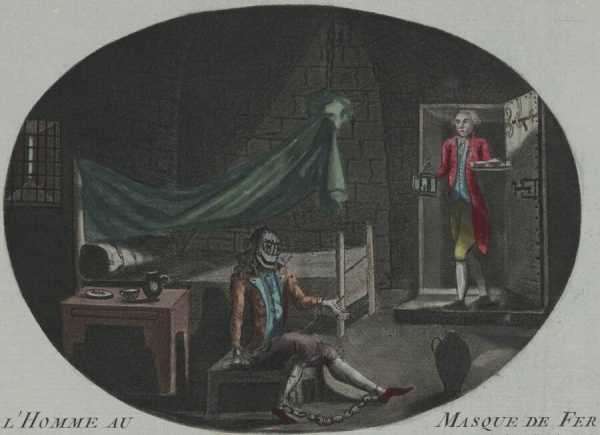
Wikimedia CommonsAn illustration of the Man in the Iron Mask in his cell.
During the reign of King Louis XIV, a mysterious man was locked away in the notorious Bastille and other French prisons: the Man in the Iron Mask. Held captive from the end of the 17th century to the beginning of the 18th century, the enigmatic prisoner still conjures up images of political intrigue, deadly betrayal, and historical enigmas.
His unforgiving mask and threadbare cell were perhaps even more infamous than the man himself. But his anonymous face obviously led to questions about his identity later on. Was he a nobleman, a prince, a political rival, or just a valet in the wrong place at the wrong time?
Who was the Man in the Iron Mask, and why was he in prison?
The Man Behind The Mask
While we may never know the true identity of the Man in the Iron Mask, we can make a few guesses based on what we do know.
Before taking up residence at the dreaded Bastille, he was held in a small prison off the coast of Cannes called Sainte-Marguerite. It was first constructed in 1617, but it didn’t become a state prison until 1685. One of the most infamous prisoners was the Man in the Iron Mask, who was said to be held there sometime during the 1680s.
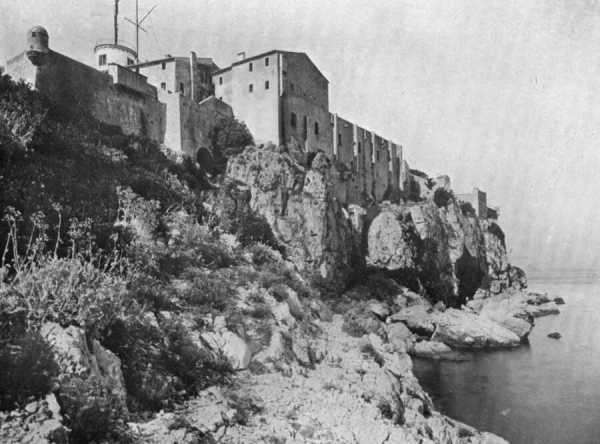
Wikimedia CommonsThe Man in the Iron Mask was locked up in Sainte-Marguerite before he was transferred to other jails.
Under the watch of former musketeer Bénigne de Saint-Mars, the Man in the Iron Mask also spent time locked up in the Pignerol and Exilles fortresses.
In 1698, a Bastille official recorded that Saint-Mars finally arrived at the infamous prison with a mysterious inmate who was “always masked and whose name is never pronounced.”
Secrecy was the name of the game for the Man in the Iron Mask. Interestingly, the “iron” detail may have even been part of the legend added later, as some have claimed that the mask was actually made of velvet.
But regardless of the mask’s material, Saint-Mars refused to say a word to anyone about what his inmate did to end up in the slammer.

Wikimedia CommonsBénigne Dauvergne de Saint-Mars, French prison governor and keeper of the Man in the Iron Mask.
“You have only to watch over the security of all your prisoners, without ever explaining to anyone what it is that your prisoner of long standing did,” wrote a minister named Barbezieux to Saint-Mars in November 1697, according to The Most Interesting Stories of All Nations.
In any case, Saint-Mars achieved his goal. The true identity of the man, and the crimes for which he was punished, will probably never be known. But of course, that didn’t stop people from guessing.
The Prisoner’s Days In The Bastille
The storming of the Bastille — the prison that housed political dissidents of the powerful — is celebrated today on Bastille Day on July 14 in France. But before the Bastille became a symbol of the country’s freedom from hierarchical oppression, it was a hulking symbol of royal power.
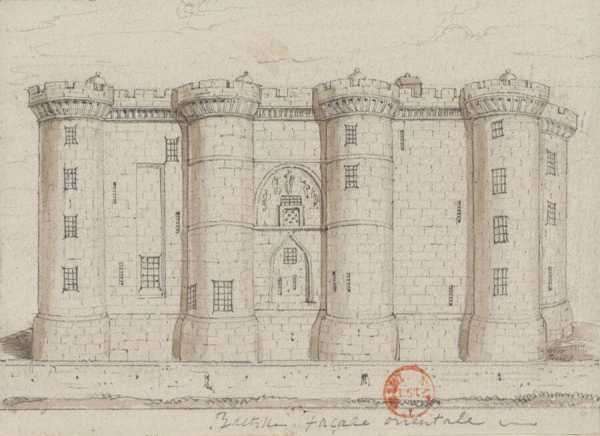
Wikimedia CommonsA sketch of the notorious Bastille prison. Circa 1790.
The Man in the Iron Mask spent his final years here in this Parisian stronghold, watched over by Saint-Mars. However, the jailer was no great protector of his captive. Recent documents from 2015 suggest that the former musketeer diverted most of the funds for supporting the prisoner’s cell to his own pockets.
Allegedly, the Bastille cell only contained a mat for sleeping — so it could not have been a pleasant stay.
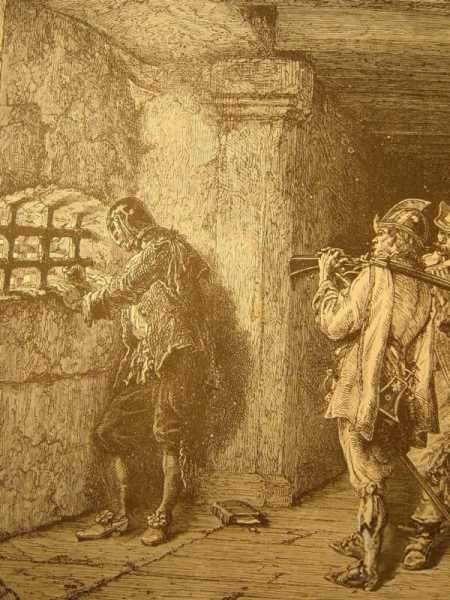
Wikimedia CommonsThe eyes of history have always been on this mysterious prisoner.
Even after his death in 1703, the very memory of the Man in the Iron Mask was subject to erasure. His clothes were promptly burned at dawn, and his cell was scraped and whitewashed to hide any trace of his identity that he may have left behind.
The French bureaucratic system worked very hard to ensure no one ever knew the real story behind the Man in the Iron Mask. But it didn’t take long for theories to emerge.
Theories About The Man In The Iron Mask
So, who was the Man in the Iron Mask? The guesses have numbered in the hundreds over the centuries, from the plausible to the far-fetched.
Historians point to two men as the most often suspected identities behind the iron mask: Ercole Matthiole and Eustache Dauger. The former was an Italian count who had betrayed Louis XIV politically in the 1670s.
His last name was so similar to an alias that was often used for the Man in the Iron Mask — “Marchioly.” On top of that, Louis XIV’s descendants Louis XV and Louis XVI had both claimed that the famous prisoner was an Italian nobleman. No wonder Matthiole was in the hot seat.
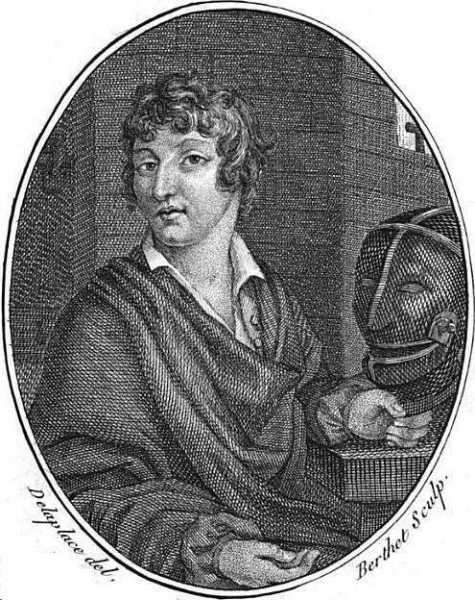
Wikimedia CommonsTo this day, no one knows what the Man in the Iron Mask’s face actually looked like.
However, Matthiole died in 1694, which was years before the Man in the Iron Mask passed away. So that’s why many experts agree that Dauger is a more likely candidate.
As for Dauger, he was reportedly a valet arrested for unclear reasons in 1669. While some say the valet was somehow implicated in a political scandal, others say he wasn’t a valet at all. He’s also been painted as a debauched nobleman or even a failed assassin.
But regardless of his former occupation, Dauger had been imprisoned in several fortresses — and he was once transported between prisons in a covered chair so that passersby would not see his face. And when he was first arrested, orders were given to jailers to “threaten him with death if he speaks one word except about his actual needs.”
Enlightenment thinker Voltaire put forth a different theory — that the prisoner may have been a brother of Louis XIV. Voltaire also specified that the mask was made of iron, describing it as such: “The chin of the mask was made of steel springs, allowing the prisoner to eat without removing it.”

Wikimedia CommonsVoltaire wrote himself into the Man in the Iron Mask’s mythos with his own theory.
Meanwhile, the Dutch people, who fighting the French during the Nine Years’ War, hoped to sow discord by spreading the rumor that the Man in the Iron Mask was the true father of the king. This rumor took root because Louis XIV was born very late into his parents’ marriage.
For some people, that was enough to convince them that his mother may have taken a lover to provide France with an heir.
This had the double effect of besmirching the king’s mother while also painting her son as a bastard, and by extension, an illegitimate ruler.

Wikimedia CommonsLouis XIV of France.
Yet another rumor suggested that it wasn’t Louis XIV’s father behind the Iron Mask, but instead his illegitimate son Louis de Bourbon.
While these theories would certainly explain why the king wouldn’t want the identity of the prisoner released, there’s never been any clear-cut evidence to prove that these ideas were true.
The Eternal Mystery
Although the iron (or velvet) mask was meant to condemn the prisoner with lifelong anonymity in his jail cell, it also gave him notoriety that still persists to this day. More than 300 years later, we still want to know the true story of the Man in the Iron Mask.
The question has inspired writers, actors, and other creatives to produce artwork illustrating their theories — to varying degrees of success.
During the 19th century, the French author Alexandre Dumas tackled the question in his historical novels. Dumas theorized that the prisoner was King Louis XIV’s twin brother Philippe, imprisoned to simplify the throne’s inheritance and keep Louis XIV in power.
Even though Dumas’ story was just based on one theory, it would eventually inspire more modern depictions of the Man in the Iron Mask — including a 1998 movie starring Leonardo DiCaprio.
A clip from the 1998 film The Man In The Iron Mask.
In the film version, Louis XIV is portrayed as a villain interested only in money and bedding women while his country starves. In the movie, the royal is also completely responsible for the unique punishment of the mask.
The torturous device is doled out for the sin his brother commits — the sin of sharing his face.
Meanwhile, the TV series Versailles, which follows the early days of the magnificent French palace, portrays Louis XIV’s brother as being obsessed with the Man in the Iron Mask.
Actor Alexander Vlahos, who plays the King’s brother Philippe, commented, “When the writer came up to me and said that that was my storyline for the year, I thought: ‘How are we going to realise this?’ because obviously it’s so steeped in mythology, no one really knows who that person was, and why he was there.”
Vlahos hits the nail on the head. We’ll probably never know the answer to one of the most burning questions in modern history: Who was the Man in the Iron Mask? All we can do is guess.
For more macabre stories, check out history’s most famous corpses. Then take a look at the curious story of the many deaths of Rasputin.
Sourse: www.allthatsinteresting.com





